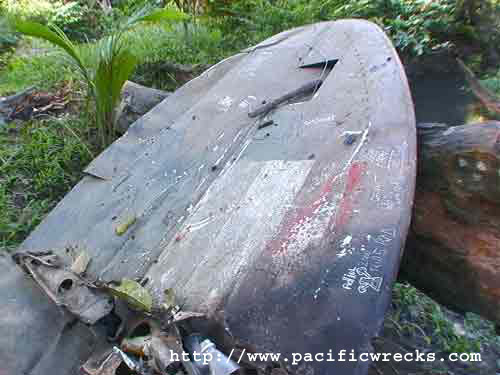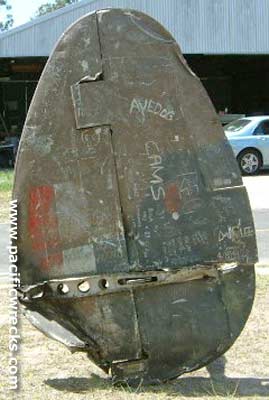|
|
|
|
| Missing In Action (MIA) | Prisoners Of War (POW) | Unexploded Ordnance (UXO) |
| Chronology | Locations | Aircraft | Ships | Submit Info | How You Can Help | Donate |
|
| RAAF 1 OTU Former assignments 2 AD No. 14 Squadron No. 13 Squadron 5 AD   Justin Taylan 2000   Robert Greinert 2004 |
Pilot S/Ldr William Allan "Pedro" Pedrina, 264 (KIA, BR) Hamilton, VIC Observer F/O Donald Beviss Kerr, 416431 (KIA, BR) Adelaide, SA Radio Sgt Arthur Rupert Itzerott, 401750 (KIA, BR) Murrumbeena, VIC Turret Gunner W/O Leo Charles Callaghan, 300400 (survived) Wanganui, NZ Crashed December 15, 1942 at 3:15pm Aircraft History Built by Lockheed Aircraft Corporation (LAC) in Burbank. Constructor Number 1887. This Hudson was never assigned a U.S. Army Air Force (USAAF) serial number. Disassembled and shipped overseas to Australia. Wartime History On February 9, 1940 delivered to the Royal Australian Air Force (RAAF) as Hudson Mark I serial number A16-36 and received by 2 Air Depot (2 AD). On May 2, 1940, assigned to No. 14 Squadron. On December 28, 1941 assigned to No. 13 Squadron. Then, transferred to 5 Air Depot (5 AD). On June 9, 1942 assigned to 1 Operational Training Unit (1 OTU). During late November 1942 until lost operated from 5 Mile Drome (Ward) near Port Moresby as part of a special transport flight of fourteen aircraft for "an indefinite period for the purposes of transporting troops, arms and equipment to the forward battle areas" in support of the Allied forces advancing on Buna, Gona and Sanananda. Mission History On December 15, 1942 took off from 5 Mile Drome (Ward) near Port Moresby piloted by S/Ldr William A. Pedrina with Hudson A16-1 and Hudson A16-127 on a mission to drop ammunition to Australian soldiers at Soputa Airfield near Soputa. This aircraft successfully completed three sorties. At 2:25pm, took off from 5 Mile Drome (Ward) on a fourth sortie to drop ammunition at Soputa Airfield near Soputa. After dropping supplies and banking away from Soputa Airfield at 100' over drop zone "Jumbora", hit by Japanese anti-aircraft fire or ground fire, shook violently then nosed up in a steep climb to 100', then dived into the trees and crashed at roughly 3:15pm near Soputa Airfield, 1.5 miles north of Jumbori. Three of the crew were killed in the crash: Pedrina, Kerr and Itzerott. Fates of the Crew Rear gunner Callaghan survived with a broken pelvis and arm. After the crash, Australian Army commandos ran to the crash site and rescued him. Callaghan returned to duty and served for the remainder of the Pacific War. On October 9, 1945 discharged from the RAAF with the rank of Warrant Officer at Station HQ Point Cook. Keith Taylor, was at the Jumbora supply dump with mate, "Smiler" Sublet, on December 14, 1942: "Spent the day checking out .303 ammunition to see if it was serviceable following the air drop. By mid afternoon, an airdrop was occurring using Hudson aircraft flown over from Port Moresby to drop their loads. Then there was a roar and they watched one of the Hudson's crash during a circuit. They raced over to help - it took around half an hour to get there through the jungle - they sang out as they approached to get a bearing and got a reply. The plane had belly landed but the fuselage was rather crushed plus the front end was on fire. The plane had come down in the jungle amidst a lot of smashed up timber. There was a crew member alive in the upper turret- Flt Sgt Callaghan. There was a lot of ammo on board and though they could see the bodies of the pilot and navigator they had no chance to get them. Flt Sgt Callaghan was the turret gunner Australian troops finally pulled out of the wreck. after smashing in the perspex. Callaghan went berserk due to his wounds, and had first tried to smash his way out with his own revolver resulting in it firing a bullet up his arm. Then when the rescuers did get a hole made, his the wounded man's belt caught on on the machine gun and he ended up with a shattered pelvis." Memorials The three crew killed in the crash were officially declared dead the day of the mission. After the crash, the remains of all three were recovered and buried. Later, they were permanently buried at Bomana War Cemetery. Pedrina at section A6 row E grave 20. Kerr at section A6 row E grave 21.Itzerot at section A6 row E grave 19. Callaghan passed away on May 12, 1988 at age 73. He is buried at Northern Suburbs Memorial Gardens and Crematorium in North Ryde, NSW at East Terrace 1, Wall 4. Wreckage This Hudson crashed into a forested area near Soputa. Recovery Sometime prior to 2000, a single .303 machine gun was recovered from the crash site by Frank Egembari and kept at his residence. During 2002, the tail fin was recovered by Robert Greinert and shipped to Australia and donated to the Australian War Museum (AWM). The tail fin does not appear in the AWM collection. References WW2 Nominal Roll - William Allan Pedrina, 264 WW2 Nominal Roll - Donald Beviss Kerr, 416431 WW2 Nominal Roll - Arthur Rupert Itzerott, 401750 WW2 Nominal Roll - Leo Charles Callaghan, 300400 ADF Serials - Hudson A16-36 CWGC - William Allan Pedrina CWGC - Donald Beviss Kerr CWGC - Arthur Rupert Itzerott FindAGrave - Squadron Leader William Allan Pedrina (grave photo) FindAGrave - Flying Officer Donald Beviss Kerr (grave photo) FindAGrave - Sergeant Arthur Rupert Itzerott (grave photo) FindAGrave - Leo Charles Callaghan Hudson Tail Fin Donated to AWM (2002) by Robert Greinert Thanks to Phil Bradley, John Douglas and Daniel Leahy for additional information Contribute Information Are you a relative or associated with any person mentioned? Do you have photos or additional information to add? Last Updated January 11, 2024 |
Hudson Photo Archive |
| Discussion Forum | Daily Updates | Reviews | Museums | Interviews & Oral Histories |
|